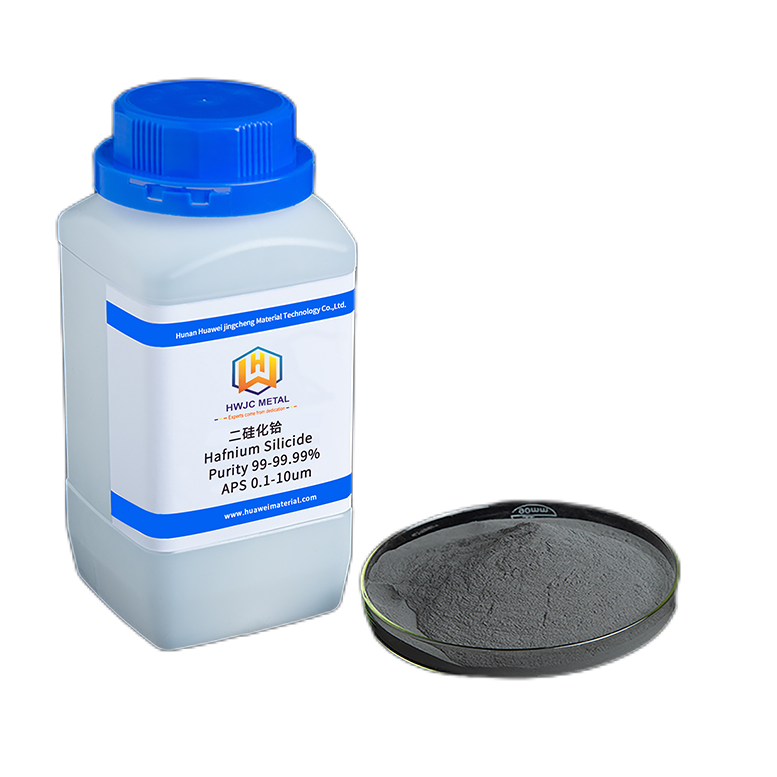Hafnium Silicide (HfSi2) is a transition metal silicide, a type of refractory intermetallic compound. Because of its unique physical and chemical properties, it is used in cermets, high-temperature oxidation-resistant coatings, high-temperature structural materials and aviation, aerospace, and other fields. In order to inhibit oxidation, enhance the erosion resistance of the matrix and make up for the defects after ablation, HfSi2 can be used as an Hf source for in-situ synthesis of HfC.
Application of Hafnium Silicide Powder:
1. Preparation of ablative composite coating of silicon carbide-hafnium silicide-tantalum silicide (SiC-HfSi2-TaSi2). Carbon fiber reinforced carbon (C / C) composite material is a new type of high temperature resistant composite material with carbon fiber as the reinforcement and pyrolytic carbon as the matrix. Because of its excellent high-temperature strength, anti-ablation properties and good friction and wear properties, in the early 1970s, the United States carried out research work on C / C composite materials for thermal structures, making C / C composite materials Development of thermal, structural materials. C / C composite materials can be used as thermal, structural materials for gas turbine engine structural components, space shuttle nose cone caps, wing leading edges, etc. Most of these components work under high temperature and oxidation environments.
However, C / C composites are easily oxidized and cannot usually be served in an oxidizing atmosphere above 400 ℃. This requires proper anti-oxidation protection for C / C composite materials, and the preparation of anti-oxidation coatings is one of the main protective measures. Studies have shown that when refractory metals Zr, Hf, Ta, TiB2, etc. are added to the carbon matrix, the ablation resistance of C / C composites can be further improved. In order to understand the influence of metal Hf and Ta on the ablation performance of C / C composites, some experiments have prepared SiC–HfSi2–TaSi2 anti-ablation coating by embedding method, and the anti-ablation coating was measured by oxyacetylene ablation device Ablation properties of the layer. Knot
2.Prepare an organic electroluminescent device. It includes an anode, a light-emitting layer, a cathode, and a package cover that are sequentially stacked. The package cover encapsulates the light-emitting layer and the cathode on the anode. The package cover includes a silicon carbonitride layer and a barrier layer formed on the surface of the silicon carbonitride layer; The material of the barrier layer includes silicide and a metal oxide, the silicide is selected from at least one of chromium silicide, tantalum disilicide, hafnium silicide, titanium disilicide, molybdenum disilicide, and tungsten disilicide, The metal oxide is selected from at least one of magnesium oxide, aluminium oxide, titanium dioxide, zirconium oxide, hafnium dioxide, and tantalum pentoxide. The above-mentioned organic electroluminescent device has a long life. The invention also provides a method for preparing an organic electroluminescent device.
3.Prepare a silicon-germanium alloy-based thermoelectric element. The silicon-germanium alloy-based thermoelectric element is composed of an electrode layer, a silicon-germanium alloy-based thermoelectric layer, and a barrier layer between the electrode layer and the silicon-germanium alloy-based thermoelectric layer. The barrier layer is a mixture of silicide and silicon nitride. The silicide is at least one of molybdenum silicide, tungsten silicide, cobalt silicide, nickel silicide, niobium silicide, zirconium silicide, tantalum silicide, and hafnium silicide. The interfaces provided in the silicon-germanium alloy-based thermoelectric element are well combined, no cracks and obvious diffusion phenomena are present at the interface, the contact resistance is small, the thermal contact state is good, and it can withstand a long-term high-temperature accelerated test. In addition, the preparation method provided has the characteristics of simple process, high reliability, low cost, no special equipment, and is suitable for large-scale production.
4. Prepare a high temperature resistant and oxidation resistant cermet composite coating. The composite film is characterized in that the coating is composed of refractory metals, refractory carbides and intermetallic compounds, and the thickness of the coating is 10 μm to 50 μm. The refractory metal is one or more of molybdenum, tantalum, zirconium and hafnium; the refractory carbide composition is silicon carbide, and one or more of tantalum carbide, zirconium carbide and hafnium carbide; The intermetallic compound consists of one or more of molybdenum silicide, tantalum silicide, zirconium silicide, hafnium silicide, tantalum carbon silicide, zirconium carbon silicide, and hafnium carbon silicide; the crystal structure of the coating is made of non- Crystalline and/or polycrystalline nanoparticles.
